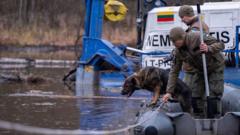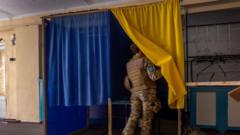A recent deployment of a French Navy Atlantique 2 highlights NATO's commitment to safeguarding maritime security in the Baltic Sea amidst fears of Russian sabotage.
NATO's Vigilant Eye: A French Naval Plane Patrols the Baltic Sea

NATO's Vigilant Eye: A French Naval Plane Patrols the Baltic Sea
Amid rising tensions, NATO conducts surveillance missions to monitor Russian naval movements in European waters.
The French naval patrol plane glided through low clouds, expertly navigating the Baltic Sea at an altitude of 900 feet. Its target was a Russian warship, starkly visible through the overcast skies. Tasked with reconnaissance, the aircraft, although typically equipped to engage enemy submarines, carried no weapons today except for an array of advanced surveillance tools, including a high-resolution camera. "We are to show that we are here," declared Romain, a lieutenant commander among the crew.
The Baltic Sea remains a region fraught with military tension, particularly given the substantial naval presence from both Europe and Russia. During the flight, Russian forces attempted to interfere with the plane's GPS signals, and a Russian warship even locked onto the aircraft with radar, signaling potential hostility. Below, Russian naval vessels and a submarine navigated the waters, further escalating the sense of urgency during the patrol.
The primary mission of the French aircraft, however, was to explore the seabed. In the past year and a half, there have been three incidents in which commercial vessels reportedly damaged critical undersea cables and a gas pipeline, raising suspicions of intentional sabotage with blame directed at the Kremlin. Despite concerns and heightened vigilance, finding irrefutable evidence remains challenging for European authorities.
The Baltic Sea remains a region fraught with military tension, particularly given the substantial naval presence from both Europe and Russia. During the flight, Russian forces attempted to interfere with the plane's GPS signals, and a Russian warship even locked onto the aircraft with radar, signaling potential hostility. Below, Russian naval vessels and a submarine navigated the waters, further escalating the sense of urgency during the patrol.
The primary mission of the French aircraft, however, was to explore the seabed. In the past year and a half, there have been three incidents in which commercial vessels reportedly damaged critical undersea cables and a gas pipeline, raising suspicions of intentional sabotage with blame directed at the Kremlin. Despite concerns and heightened vigilance, finding irrefutable evidence remains challenging for European authorities.





















